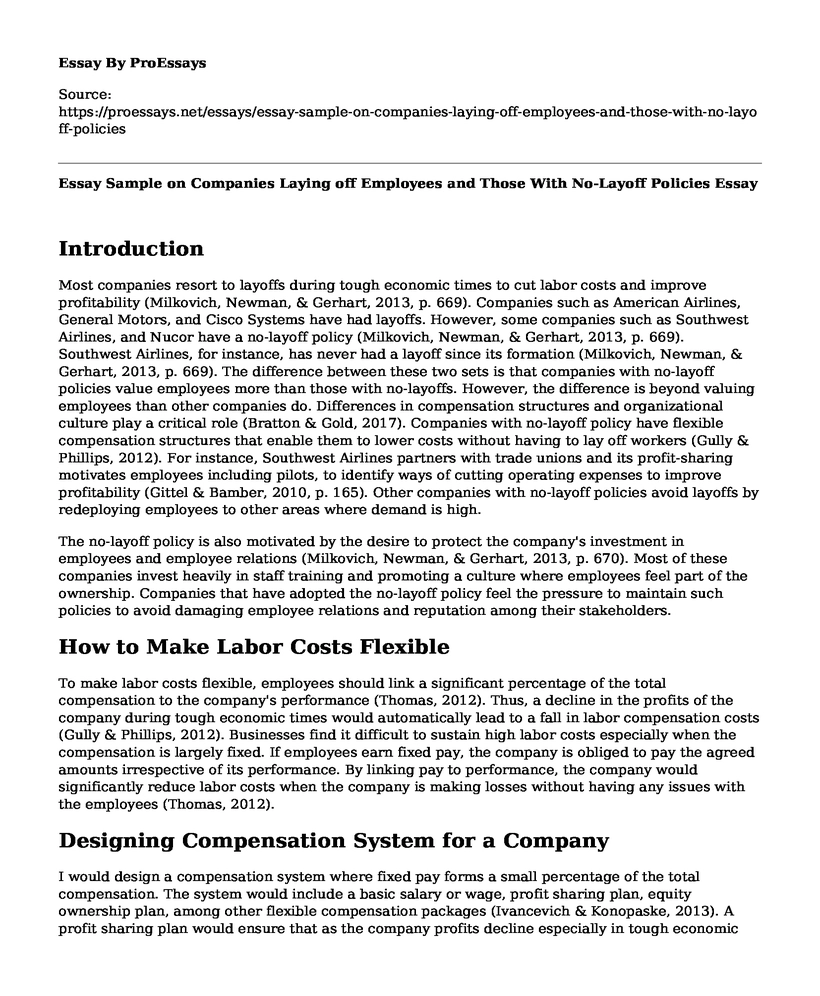Introduction
Most companies resort to layoffs during tough economic times to cut labor costs and improve profitability (Milkovich, Newman, & Gerhart, 2013, p. 669). Companies such as American Airlines, General Motors, and Cisco Systems have had layoffs. However, some companies such as Southwest Airlines, and Nucor have a no-layoff policy (Milkovich, Newman, & Gerhart, 2013, p. 669). Southwest Airlines, for instance, has never had a layoff since its formation (Milkovich, Newman, & Gerhart, 2013, p. 669). The difference between these two sets is that companies with no-layoff policies value employees more than those with no-layoffs. However, the difference is beyond valuing employees than other companies do. Differences in compensation structures and organizational culture play a critical role (Bratton & Gold, 2017). Companies with no-layoff policy have flexible compensation structures that enable them to lower costs without having to lay off workers (Gully & Phillips, 2012). For instance, Southwest Airlines partners with trade unions and its profit-sharing motivates employees including pilots, to identify ways of cutting operating expenses to improve profitability (Gittel & Bamber, 2010, p. 165). Other companies with no-layoff policies avoid layoffs by redeploying employees to other areas where demand is high.
The no-layoff policy is also motivated by the desire to protect the company's investment in employees and employee relations (Milkovich, Newman, & Gerhart, 2013, p. 670). Most of these companies invest heavily in staff training and promoting a culture where employees feel part of the ownership. Companies that have adopted the no-layoff policy feel the pressure to maintain such policies to avoid damaging employee relations and reputation among their stakeholders.
How to Make Labor Costs Flexible
To make labor costs flexible, employees should link a significant percentage of the total compensation to the company's performance (Thomas, 2012). Thus, a decline in the profits of the company during tough economic times would automatically lead to a fall in labor compensation costs (Gully & Phillips, 2012). Businesses find it difficult to sustain high labor costs especially when the compensation is largely fixed. If employees earn fixed pay, the company is obliged to pay the agreed amounts irrespective of its performance. By linking pay to performance, the company would significantly reduce labor costs when the company is making losses without having any issues with the employees (Thomas, 2012).
Designing Compensation System for a Company
I would design a compensation system where fixed pay forms a small percentage of the total compensation. The system would include a basic salary or wage, profit sharing plan, equity ownership plan, among other flexible compensation packages (Ivancevich & Konopaske, 2013). A profit sharing plan would ensure that as the company profits decline especially in tough economic periods, the total compensation decreases; hence the company can cope without having to lay off any employee (Ivancevich & Konopaske, 2013). Equity ownership plans would motivate employees to work hard since the value of their shares would decline if the company is making losses (Thomas, 2012).
Participation in the Design of Compensation System
I would involve all the relevant stakeholders in designing the compensation system. Participants would include employees through their representatives, all other departmental heads, and the company's executive. Employees must be involved in the process to motivate them since participation in such a process makes employees feel they are part of the company's ownership (Mathis, Jackson, Valentine & Meglich, 2017). Besides, a compensation system cannot work if employees and other stakeholders do not approve of it. Participation will reduce resistance and gain employees' approval of the system (Mathis, Jackson, Valentine & Meglich, 2017). It is also important to cultivate a suitable organization culture. For instance, when employees understand the organization and are motivated, they will undertake appropriate measures in the course of their duties to reduce costs and improve the profitability of the company.
Policy of Pay Openness
A policy of pay openness within the company would be suitable. It enhances transparency in the pay structure thereby eliminating perceptions of unfairness and bias (Hartman & Slapnicar, 2012). Besides, it enhances employees' understanding of how their pay is determined thereby improving their motivation (Hartman & Slapnicar, 2012). This ensures that employees know the performance areas they need to adjust to improve their performance and increase their pay.
References
Bratton, J., & Gold, J. (2017). Human resource management. London: Palgrave Macmillan.
Gittel, J. H., & Bamber, G. J. (2010). High- and low-road strategies for competing on costs and their implications for employment relations: international studies in the airline industry. The International Journal of Human Resource Management, 21(2), 165-179.
Gully, S., & Phillips, J. (2012). Staffing to Support Business Strategy. Chicago: Society for Human Resource Management.
Hartman, F., & Slapnicar, S. (2012). Pay fairness and intrinsic motivation: the role of pay transparency. The International Journal of Human Resource Management, 23(20).
Ivancevich, J., & Konopaske, R. (2013). Human resource management. New York, NY: McGraw-Hill Irwin.
Mathis, R., Jackson, J., Valentine, S., & Meglich, P. (2017). Human resource management. Boston, MA: Cengage Learning.
Milkovich, G., Newman, J., & Gerhart, B. (2013). Compensation. University of Oregon, John Henry Nash Fine Arts Press.
Thomas, P. (2012). Effectiveness of pay for performance and fixed pay practices: An assessment of pay satisfaction, commitment and turnover intention. International Journal of Research in Commerce, It & Management, 2(12).
Cite this page
Essay Sample on Companies Laying off Employees and Those With No-Layoff Policies. (2022, Dec 07). Retrieved from https://proessays.net/essays/essay-sample-on-companies-laying-off-employees-and-those-with-no-layoff-policies
If you are the original author of this essay and no longer wish to have it published on the ProEssays website, please click below to request its removal:
- Employment Outlook in Accounting in the Next Five Years
- Operation in the Global Market Essay
- Evaluation Paper Example on Apple Company
- Effects of a Nuclear-Powered World Essay Example
- Financial Analysis of Apple Company Paper Example
- Essay Example on Mandatory Subject of Bargaining: Employer-Union Negotiations
- Minimum Wage: A Price Floor for Workers' Rights - Essay Sample







